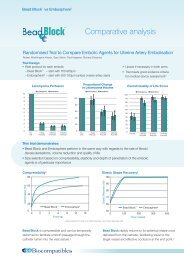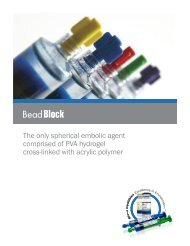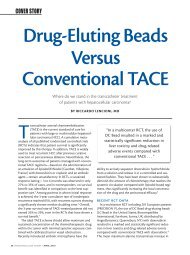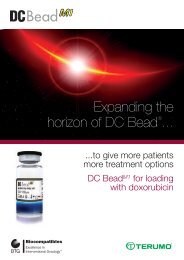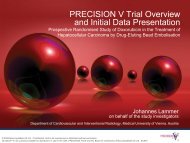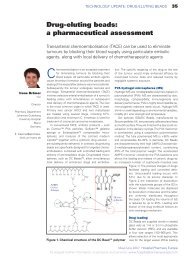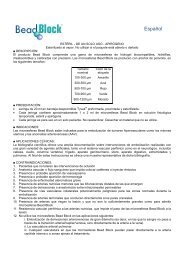Professor Lencioni ILCA 2011.pdf - Biocompatibles
Professor Lencioni ILCA 2011.pdf - Biocompatibles
Professor Lencioni ILCA 2011.pdf - Biocompatibles
You also want an ePaper? Increase the reach of your titles
YUMPU automatically turns print PDFs into web optimized ePapers that Google loves.
Is DEBDOX the New Standardfor Chemoembolization?<strong>Professor</strong> Riccardo <strong>Lencioni</strong>, MDDirector, Division of Diagnostic Imaging and InterventionDepartment of Hepatology and Liver TransplantationPisa University Hospital and School of MedicinePisa, Italy
Disclosures• DC Bead® is a registered trademark and DEBDOX is a trademark of<strong>Biocompatibles</strong> UK Ltd.• DC Bead is CE marked and is indicated for the treatment of malignanthypervascular tumours and loading with doxorubicin drug. DC Bead® is alsoindicated for loading with irinotecan for the treatment of metastatic colorectal cancer(mCRC).• For full prescribing information please refer to www.biocompatibles.com/dcbead-ifu.Both products may not be available in your territory.• DC Bead and DEBDOX are not cleared by the FDA for sale or distribution orpromotion in the USA.• <strong>Professor</strong> <strong>Lencioni</strong> is a consultant to <strong>Biocompatibles</strong> UK Ltd.• EC11-254 Rev 1 © 2011 <strong>Biocompatibles</strong> UK Ltd.
BCLC staging system and treatment strategyHCCPS 0, Child–Pugh APS 0–2, Child–Pugh A–BPS > 2, Child–Pugh CVery early stage (0)Single< 2 cmEarly stage (A)Single or 3 nodules< 3 cm, PS 0Intermediate stage (B)Multinodular,PS 0Advanced stage (C)Portal invasion,N1, M1, PS 1–2End stage (D)Single3 nodules ≤ 3 cmPortal pressure/bilirubin↑Associated diseasesNormalNoYesResectionTransplantAblationTACESorafenibBSCadapted from Bruix J, Sherman M. Hepatology 2011;53:1020-2
TAE / TACE versus BSC / suboptimal therapy:meta-analysis of RCTs (2-year survival)Author, journal yearPatientsRandom effects model (DerSimonian and Laird)Odds ratio (95% CI)Lin, Gastroenterology 1988 63GETCH, NEJM 1995 96Bruix, Hepatology 1998 80Pelletier, J Hepatol 1998 73Lo, Hepatology 2002 79Llovet, Lancet 2002 112Overall503Heterogeneity p=0.14Favours treatmentz=–2.3p=0.0170.01 0.1 0.5 1 2 10 100Favours controladapted from Llovet JM, Bruix J. Hepatology 2003;37:429-42
Probability of survival (%)Probability of survival (%)Conventional TACE: long-term outcomes areunsatisfactory• 3-year overall survival in the TACE treatment arm: 26% – 29%• Sustained objective response (lasting > 3–6 months): 27% – 35%ChemoembolisationControlChemoembolisationControlp=0.009p=0.0020 12 24 36 48 60 0 6 12 18 24 30 36 42Months from randomizationMonths from randomizationadapted from Llovet JM et al. Lancet 2002;359:1734–9 adapted from Lo CM et al. Hepatology 2002;35:1164–71
Conventional TACE: liver toxicity is a majorlimitation of Lipiodol-based regimens“In a group of patients with unresectable HCC but without severe liver disease,Lipiodol chemoembolization often caused acute liver failure and did notsignificantly improve survival”GETCH. N Engl J Med 1995;332:1256-61
Conventional TACE: treatment discontinuationdue to AEs or technical issues is common• Reasons for treatment discontinuation among HCC patients who received aconventional TACE regimen with doxorubin, Lipiodol, and gelatine spongefragmentsadapted from Llovet JM et al. Lancet 2002;359:1734–9
Drug eluting bead doxorubicin (DEBDOX) vsconventional TACE: Pharmacokinetics• Serum doxorubicin levels at different time points after TACE with drugeluting bead doxorubicin (BTG- <strong>Biocompatibles</strong>) or conventional TACEVarela M et al. BCLC. J Hepatol 2007;100:698-711
Drug eluting bead doxorubicin (DEBDOX) vsconventional TACE: A RCT (PRECISION V)• International multicenter phase II study of DC Bead (BTG-<strong>Biocompatibles</strong>)with doxorubicin versus conventional Lipiodol TACE with doxorubicinPatientsrandomized1:1(n=212)TACE with DC BeadDoxorubicin dose = 150mgConventional TACEDoxorubicin dose = 50–75mg/m 2(maximum 150mg)TACE repeated at 2 and 4 monthsTACE repeated at 2 and 4 months• Primary endpoint: 6-month tumor response by central independent review• Secondary endpoints included safety (toxicity according to SWOG)Lammer J et al. Cardiovasc Intervent Radiol 2010;33:41-52
AST Units/LALT Units/LDEBDOX vs cTACE: Drug-related AEs and livertoxicity are markedly reduced300250200p=0.001150p=0.001100500200150DC BeadcTACEp
DEBDOX vs cTACE: Response rates are higherin patients with more advanced diseasep = 0.11Overall response at 6 monthsResponse: subgroup analysisLammer J et al. Cardiovasc Intervent Radiol 2010;33:41-52
DEBDOX vs cTACE: Response rates are higherin patients with more advanced diseaseDEBDOX shows significant advantagefor objective response (p=0.038)and disease control (p=0.026)Lammer J et al. Cardiovasc Intervent Radiol 2010;33:41-52
SongMalagariPoonVarela<strong>Lencioni</strong>ReyesLLovetLoDEBDOX vs conventional Lipiodol TACE:Tumor response ratesTumor Response Rate (%)8580 -70 -60 -50 -737066606052444030--352720-10-0DEBDOXPRECISION VcTACE<strong>Lencioni</strong> R. Personal communication.
DEBDOX: Development of proceduralstandards and technical recommendationsTranscatheter Treatment of Hepatocellular Carcinoma withDoxorubicin-Loaded DC Bead: Technical RecommendationsRiccardo <strong>Lencioni</strong> 1 , Thierry de Baere 2 , Martha Burrel 3 , James G. Caridi 4 , Johannes Lammer 5 ,Katerina Malagari 6 , Robert C. Martin 7 , Elisabeth O’Grady 8 , Maribel Real 3 , Thomas J. Vogl 9 ,Anthony Watkinson 10 , Jean-Francois H. Geschwind 11• Bead size: 100-300μm• Loading dose: 25-37.5 mg doxorubicin / ml of beads• Dilution: 5-10 ml contrast / ml of beads• Injection rate: 1 ml / minute• Tumor response by mRECIST for HCC<strong>Lencioni</strong> R et al. (under review)
DEBDOX vs conventional Lipiodol TACE:Where do we stand?• Compared with conventional TACE, drug eluting bead has a standardizedmethodology, is more reproducible, and offers improved response and asignificantly better safety profile.Raoul JL et al. Cancer Treat Rev 2011;37:212-20


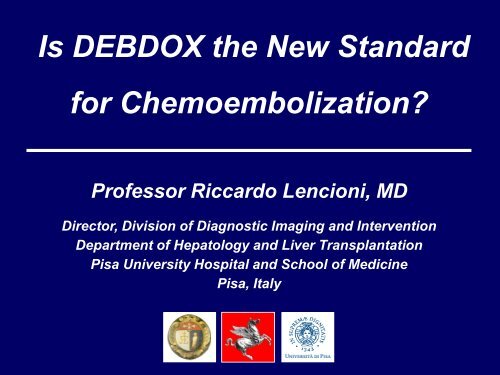
![Drug-Eluting Bead TACE with DC Bead® [DEBDOXâ¢] in the ...](https://img.yumpu.com/50840371/1/184x260/drug-eluting-bead-tace-with-dc-beadar-debdoxa-in-the-.jpg?quality=85)

